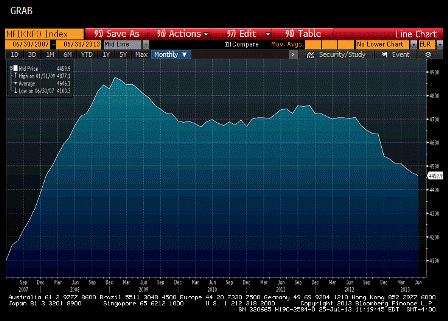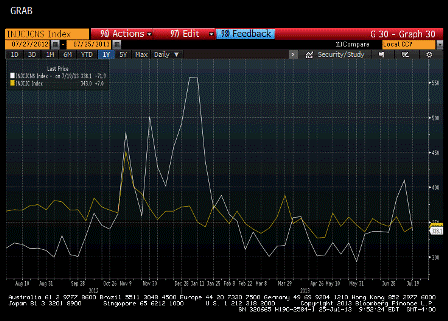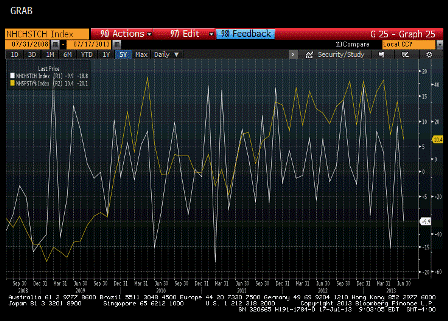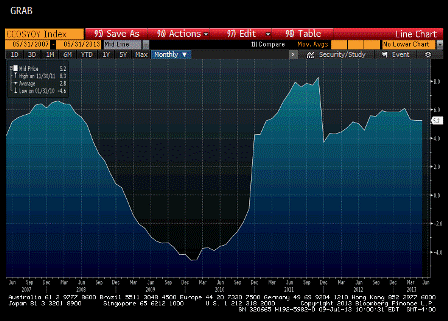Dozens killed as Egypt security forces clash with Morsi supporters in Cairo
By Ayman Mohyeldin, Marian Smith and Elizabeth Chuck
July 26 (NBC) — At least 100 people were killed early Saturday when riot police fired on protesters supporting deposed Egyptian President Mohammed Morsi in Cairo, activists said.
The Anti-Coup Alliance, an umbrella coalition of Morsi supporters, also said at least 5,000 people were injured near the clash in the Nasr City neighborhood of the capital.
Category Archives: Uncategorized
More on EU Private Sector Credit Expansion
ECB Says Bank Loans to Private Sector Shrink Most on Record
By Jeff Black
July 25 (BN) — Lending to companies and households in the 17-member euro area fell the most on record in June in a sign the region is still struggling to shake off its longest-ever recession.
Loans to the private sector dropped 1.6 percent from a year earlier, the Frankfurt-based European Central Bank said today. That’s the 14th monthly decline and the biggest since the start of the single currency in 1999.
The rate of growth in M3 money supply, which the ECB uses as an indicator for future inflation, fell to 2.3 percent in June from 2.9 percent in May, according to today’s data. That’s below all 30 estimates in a Bloomberg survey of economists.
M3 grew 2.8 percent in past three months from the same period a year earlier. M3 is the broadest gauge of money supply and includes cash in circulation, some forms of savings and money-market holdings.
A Few Charts
Claims were looking to be lower due to auto workers working through the usual layoff period, but they remained high on the seasonally adjusted basis and looks to have rebounded from the April soft spot and subsequently gone sideways.
The EU has been struggling with something like we might be faced with- proactive deficit reduction and a private sector not stepping up to ‘borrow to spend’ to fill the gap.
Today’s durable goods shipments shortfall has caused further reductions in Q2 GDP estimates. Yes, new orders look promising, and Q3 estimates are still in the 2.5% range. And I remain on the lookout for signs of the credit expansion needed to support those forecasts in the context of the reduced federal deficit and the aggressive automatic fiscal stabilizers that remove income and savings of net financial assets as the economy grows.
Today’s combo of lower stocks and higher bond yields has been the typical response to an increased tapering possibility, along with the recently increased possibility of Summers as Fed chairman, with his presumably higher inclination to hike rates than Yellen.
EU Loans to Non Financial Corporations Outstanding

Full size image
EU Loans to Households Outstanding

Full size image
Initial US Jobless Claims SA and NSA

Full size image
Beer sales take a knock from payroll tax hike
Now this is serious!
Beer sales take a knock from payroll tax hike
By Arjun Kharpal
July 23 (CNBC) — U.S. beer sales declined in the first half of 2013 fueled by the payroll tax hike and a jump in unemployment among young men, according to research published on Tuesday.
The beer market posted 1 percent growth in 2012, in-line with pre-recession averages, driving hopes that the worst was over for the industry.
But beer sales dropped 3 percent in the three months to May 2013 and are down 2.6 percent in the year to date, Bernstein Research analysts said in a note.
bowling
Housing Starts in U.S. Unexpectedly Fall to Lowest in a Year
First, this isn’t even being reported on CNBC and is only way down on Bloomberg’s website.
Second, this is the last thing an economy faced with a demand shock from tax hikes and sequesters needs. Housing is the sector of hope for agents’ spending more than their incomes to offset the mounting demand leakages.
Third, the Fed Chairman’s remarks regarding fiscal headwinds having more effect than expected and continuing longer than expected have largely gone unreported as well. He’s right, of course, and in fact the ‘permanent’ deficit reduction is just that, and not only doesn’t go away but makes the fiscal headwinds of the automatic stabilizers that much more of an obstacle.
Fourth, seems ‘confidence’ isn’t all it’s been cracked up to be, as previously discussed…
Housing Starts in U.S. Unexpectedly Fall to Lowest in a Year
Starts of new U.S. homes unexpectedly fell in June to the lowest level in almost a year, indicating a pause in the industry’s progress.
Work began on 836,000 houses at an annualized rate last month, the least since August 2012 and down 9.9 percent from a revised 928,000 pace in May, figures from the Commerce Department showed today in Washington. The reading was weaker than projected by any economist in a Bloomberg survey, and permits for future projects also declined.
The decline was led by a slump in multifamily projects, which can be volatile, and the level of permits remained higher than starts, which may point to a rebound this month. A limited supply of land is also a hurdle for housing, even as near record-low mortgage rates and improving job opportunities draw buyers.
“Housing will continue to grow, but it will be at a gradual pace,” Sean Incremona, a senior economist at 4Cast Inc. in New York and the top forecaster for housing starts in the past two years, according to data compiled by Bloomberg, said before the report.
The median estimate of 83 economists surveyed by Bloomberg was for a 960,000 rate. Forecasts ranged from a 915,000 pace to a 1.03 million rate after an initially reported 914,000 annualized rate in May.
Building permits decreased 7.5 percent to a 911,000 annualized rate in June, compared to a median forecast of 1 million.Single Family
Construction of single-family houses fell 0.8 percent to a 591,000 rate, the fewest since November, from 596,000 the prior month.
Work on multifamily projects such as apartment buildings slumped 26.2 percent to an annualized rate of 245,000, the lest since August 2012.
Private Housing Authorized by Building Permits SAAR

Full size image
US New 1 Unit Privately Owned Housing Units Started SAAR

Full size image
Private Housing Units Started Total MoM and YoY SA

Full size image
Egypt, etc.
Keep you eye on this.
The struggle has only just begun seems:
Egyptian Government Expands Crackdown on Muslim Brotherhood
July 11 (FP) — Top news: Egypt’s new military-led government broadened its crackdown on the Muslim Brotherhood on Wednesday, issuing arrest warrants for nine top Brotherhood officials, including Mohamed Badie, the group’s spiritual leader. Prosecutors charged all nine with inciting violence against the military and inviting the clashes that left 51 dead on Monday outside the Cairo headquarters of the Republican Guards. (Witnesses attest that the military opened fire with little provocation.) Authorities have already detained five top Brotherhood officials, including deputy leader Khairat el-Shaiter, as well as ousted President Mohamed Morsi and several of his top lieutenants.
Meanwhile, the restoration of power, disappearance of gas lines, and immediate deployment of police forces after the last week’s military takeover suggest that remnants of Hosni Mubarak’s regime played a significant role in undermining Morsy’s prior to his ouster. “This was preparing for the coup,” Naser el-Farash, a spokesman for the Ministry of Supply and Internal Trade under Mr. Morsy told the New York Times. “Different circles in the state, from the storage facilities to the cars that transport petrol products to the gas stations, all participated in creating the crisis.”
Despite the unrest, American officials indicated on Wednesday that they plan to move ahead with the delivery of four new F-16 fighter jets to Egypt as part of the United States’ annual military assistance.
Proud to be an American? :(
And:
NatSec: An experimental X-47B Navy drone landed successfully on the U.S.S. George H.W. Bush on Wednesday, marking the end of an eight year trial program for testing the feasibility of basing long-range drones aboard aircraft carriers. “What you saw here is the first of the next generation of naval aircraft and the amazing capabilities it will give us,” Navy Secretary Ray Mabus said of the bat-winged X-47B. Still, as FPreports on Killer Apps, the future of the Navy’s stealth drone program remains murky at best.
US Jobless Claims Jump Above Forecasts; Prices Still Tame
The data continues to support the narrative:
Proactive deficit reduction, aka ‘austerity’, slows an economy and can throw it into reverse if some other agent’s deficit spending/savings reduction doesn’t rise to the occasion.
And add to that the growing headwind of the now highly aggressive ‘automatic fiscal stabilizers’ with a deficit now probably running at a pace well under 3% of GDP.
As you know I’ve been looking for any sign of credit expansion and so far I see nothing but deceleration. Mortgage credit outstanding continues to contract, housing starts have gone sideways, and most recently mtg apps have actually turned down. Unemployment claims seem to have bottomed earlier this year and the 3 month moving average has turned up as well. Year over year consumer credit growth is flat, and bank lending in general remains only very modestly positive, with no sign of a recent increase needed to fill the ‘spending gap’ left by a retreating govt sector.
Furthermore, GDP has been revised down to be consistent with my narrative, with Q1 now down to 1.8% and Q2 estimates in the 1%- 1.5% range. And, as discussed yesterday, with long term productivity somewhere around that level, jobs should go from up 200,000 to flat, with a lag of course. In other words, the upturn in claims that leads jobs is offering more support for that narrative.
Additionally, the risk of it all going into reverse is mounting as well. This happens when the deficit- the net financial equity of the economy- isn’t sufficient to support the credit structure that’s supporting growth. And the way the deficit gets higher is via the automatic fiscal stabilizers going into reverse- the slowing economy increases transfer payments and reduces revenues.
Also note the evidence of global disinflation including commodity prices, a general fade of the emerging market sector, and Europe at best getting modestly less worse. Only Japan has had some growth, but none of it is about growing imports, so it’s no help to anyone else, and their 25% real wage pay cut and increased exports/lower prices is reducing domestic demand abroad and deflating prices and margins abroad.
For more data, scroll down through www.moslereconomics.com where I’ve been posting charts with the data releases. Hint: they all show a general deceleration.
Conclusion- we are in the midst of a global, broad based fiscally induced set of contractionary/deflationary forces.
Supporting optimism is the notion that ‘yes the fiscal drag from the tax hikes is subtracting from growth, but when it ends growth will return as the underlying private sector is growing at over 3%”
Yes, that’s possible, but again, it means private sector credit growth has to be there offering ever increasing support to offset the ‘demand leakages’ and to overcome the fiscal headwinds of the automatic fiscal stabilizers. And note that the automatic fiscal stabilizers are just that. They work to reverse declines by automatically increasing the deficit, and work to end expansions by automatically decreasing the deficit. So they will end the up leg in any case, and pro active deficit reduction only hastens that outcome in any case.
So after the tax hikes and sequesters have ratcheted down growth and lowered the deficit as well, the question is whether the economy will grow from that point.
I agree it’s not theoretically impossible, but it takes ever expanding private sector credit expansion, which is asking a lot from our current institutional structure.
And, of course, the portfolio shifting in reaction to the QE placebo is it’s own can of worms…
US Jobless Claims Jump Above Forecasts; Prices Still Tame
The number of Americans filing new claims for unemployment benefits rose last week, although the level still appeared to point to healing in the nation’s job market. Meanwhile, prices for U.S. imports and exports fell in June for the fourth straight month.
Initial claims for state unemployment benefits increased by 16,000 to a seasonally adjusted 360,000, the Labor Department said on Thursday.
Consumer Credit Year Over Year
I keep looking for domestic credit expansion, to fill the ‘spending gap’ left by the tax hikes and sequesters.
The headline uptick in consumer credit looked promising, but seems there’s some kind of ‘seasonal’ factor at work, as it’s done this every year for the last three years, so the year over year change isn’t showing any signs of life.
Nor is mortgage debt outstanding or any other measure of lending that I’ve seen showing any material growth.
I’m now hearing Q2 GDP growth estimates are down to +1 to + 1.5% or so. This is to be expected when the federal deficit reduction measures aren’t being ‘offset’ by domestic credit expansion and/or increased net exports. In fact, the higher than expected trade deficit was the latest thing to pushing down GDP estimates.
Worse, with a bit of a lag, lower GDP growth = lower sales growth= lower job growth (presuming ‘productivity’ doesn’t collapse) and then the lower job growth feeds back into lower sales, etc.
So yes, more jobs mean more income for those working, but without sales and earnings growth their paychecks reduce corporate incomes which then drives ‘negative adjustments’ in hiring policy, etc.
The answer, as always, is quite simple- cut taxes and/or increase govt spending, depending on one’s politics.
Unfortunately govt- and not just our govt, but all govt that I know of- is still going the other way and continuing to make things worse.

Full size image

